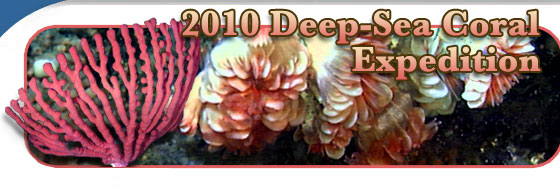Error processing SSI file
|
Blog June 24, 2010:
Leg 2 Summary
Dan Howard, Chief Scientist Leg 2
Superintendent of Cordell Bank National Marine Sanctuary
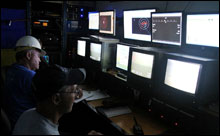 |
| Inside the ROV control van, Dennis Arbige pilots and Jeff Hyland assists with navigation. (Photo: OCNMS) |
Leg two of the 2010 NOAA Deep Sea Coral Cruise ended on an upbeat
note allowing us a glimpse into a different world. Despite poor weather
conditions and a medical emergency that required returning to port, the
weather gods smiled on us and the ocean calmed a bit allowing the ROV
team from the University of Connecticut to launch the vehicle. For 11
hours we surveyed the continental slope west of Cordell Bank in depths
between 180 and 520 meters. The serene conditions hundreds of meters
below the surface were in sharp contrast to rollicking seas and strong
winds we were experiencing on the ship.
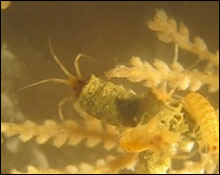 |
 Primnoid sea fan with amphipods. Click here to watch the video. Primnoid sea fan with amphipods. Click here to watch the video. |
As the ROV traversed along the continental slope, we had over 100 observations of six species of deep corals during the dive. The importance of structure forming corals was immediately apparent. Two of the species we observed, Paragorgia sp. (the bubble gum coral) and an unidentified Primnoid coral that looks like a lacey fan, are important structure forming corals that provide three dimensional habitats for other species on the deep slope. The lacey, white Primnoid corals were often covered with an assortment of invertebrates including skeleton shrimp, brittle stars, sponges, and the occasional shark egg case attached to the base of the coral. Rockfishes (Sebastes spp.) were often in close association with the corals, usually laying on the substrate next to the base of the coral. It's apparent that these deep water corals are an integral member of the deep water community. Peter Etnoyer, the coral expert on our cruise, collected one of the Primnoid corals so he could confirm its taxonomic identification in the laboratory.
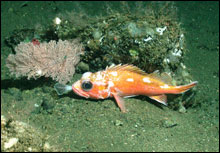 |
| Rockfish digests his lunch next to a Primnoid coral. |
Another important accomplishment during this cruise was collecting geo-referenced video across a variety of soft, hard, and mixed bottom types that can be used to ground truth or verify our habitat maps. Guy Cochrane, a geophysicist with the U.S. Geological Survey, was on the cruise and provided a set of habitat maps that he created using data from an earlier multi-beam sonar survey. These maps are not completely reliable until they can be compared to the actual substrate. Guy will be able to use video from this cruise to improve the accuracy of the habitat maps. We can use the improved maps in the future to better locate hard substrates that indicate coral habitat and subsequently deep water corals.
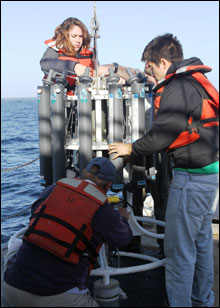 |
| Brendan Roark, Sarah Stryker, and Adrian Miner prepare the CTD for deployment. |
At night time, two graduate students and oceanographer
Brendan Roark from Texas A&M University, collected
water samples and used the ship's CTD to measure ocean
conditions along a cross shelf transect. The water samples
will be analyzed at the University of Washington and NOAA's Pacific Marine Environmental Laboratory to help characterize the ocean chemistry in the Gulf of the Farallones and Cordell Bank sanctuaries. This information will help us set a base line for parameters that describe ocean acidification which can negatively impact deep corals.
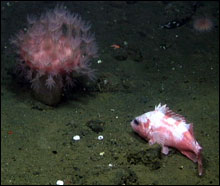 |
| Rockfish next to coral, Anthomastus ritteri. |
Visiting this deep water habitat for the first time was an incredible opportunity for us to learn about deep corals and the sanctuary. Nearly 30% of Cordell Bank sanctuary is in water deeper than 200 meters. Learning about corals and deep water communities will allow us to make more informed management decisions and do a better job protecting our amazing ocean environment. In addition, these observations may help to inform the Pacific Fisheries Management Council in their considerations for designating or extending Essential Fish Habitat along the west coast
|

